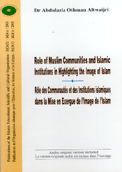
Role of Muslim Communities and Islamic Institutions
in Highlighting the Image of Islam
Status of Islamic Institutions
The right method in studying a case or analysing a situation whatsoever stipulates that this case or situation be dealt with in relation to the general environment in its various sides. Therefore, it is uncommon for the Islamic institutions to deviate from this principle. These institutions are part and parcel of the general situations pertaining to the reality of the Islamic world on which they are dependent and by which they are influenced in a harmonious way. They cannot dissociate from it; they will crumble and disintegrate unless the whole Islamic structure is powerful, wholesome and active and vice versa. Therefore, each of these institutions is a variable expression of the nature of its immediate environment and resumes the outcome of the conditions of the Islamic world.
There is nevertheless a group of Islamic institutions which provide a tangible exception to this rule. This group of institutions have succeeded in coping with the immediate conditions, surmounting difficulties and rising up to a successful degree in good administration, high performance and the positive and effective influence in the environment in which they operate. Not all Islamic institutions are similar, they differ from one environment to the other and under one circumstance or the other, and their effectiveness also differs under one administration or the other.
If we look at the Islamic institutions from this angle, we will see that there are two levels :
- First level : there are the public Islamic institutions, whether they fall under the Organization of the Islamic Conference or refer to the governmental organizations concerned with the policies elaborated and adopted by states. These institutions are diverse and many, including organizations, corporations, agencies, universities, institutes, associations and academies. The lack of financial resources is almost the common denominator between these institutions which results in a lack of human resources and a vague influence on both the local and regional as well as the general levels. This results in a remarkable failure to realize the objectives that are adopted either upon foundation or by the parent organizations in their periodical sessions, such as general conferences, executive councils, secretary councils, etc. which results in a state of complete scepticism as to the ability of many of those institutions to discharge the mission with which they were entrusted.
- Second level : the general public Islamic institutions, commonly known as “the popular Islamic institutions”, although there is a systematic flaw in this expression. Because, actually, every Islamic institution is popular; since its activity is intended for the general public, if not mainly suitable for the whole Muslim peoples. These institutions are affected by and large by a number of pressures. To the fore of these comes the increasing deficit in financial resources. As most of these institutions are subject to the influence of sponsoring authorities which do not often completely adopt the objectives these institutions have been destined to achieve. As a consequence, this results in a sporadic and irregular deviating from the designed course to the detriment of the credibility of the Islamic action in one way or the other.
In some cases, these two levels sometimes overlap so that all differences disappear. That is to say that the factors affecting the Islamic institutions at the first level are the same factors influencing the Islamic institutions at the second one. However, each level has its circumstances, environment and particular characteristics.
The Islamic world has witnessed a number of factors that engendered the present situation in which Islamic institutions find themselves. Among these are the political, economic, social and cultural situations through which the Muslim countries have been wading through during the last decades. This produced a strong influence, positively and negatively, on the totality of the activities undertaken by the joint Islamic action, which rebounded on these institutions, affecting the credibility of some and undermining the productivity of the others. Even the institutions which succeeded in surmounting and overcoming these factors were not spared the effects of the prevailing circumstances in their immediate environment.
In addition to what has been mentioned above, the other elements that contributed in undermining most of the Islamic institutions are the marshalling of forces hostile to Islam and the Muslim Ummah, their connivance, craftiness and unanimous resolution to harm this invaluable religion, to sow seeds of discord among Muslims, to dash their efforts and to hamper all endeavours conducive to their consolidation, unity and unanimity as to all that avails the Ummah and abides.
Nevertheless, we do not impute the defect of Islamic institutions and their deficiency absolutely to external factors. We believe that there is an external influence which partly caused this to happen and that Muslims bear their own share of responsibility in any case.
It can be said that the success of some Islamic institutions in discharging the role they were entrusted with is in itself one of the salutary phenomena prevalent in the Islamic world. It is all the more inappropriate to make a general judgment about all Islamic institutions, since there are institutions that have succeeded in acquitting their mission; others facing obstacles in fulfilling their duties and there are also institutions which, for some reasons, both fail and succeed in bringing their objectives to an end.
But, on the whole, we can put emphasis in this connection on the fact that the degree of success for Islamic institutions in assuming their functions is not on par with the targeted objectives and does not fully meet the hopes pinned on them since their creation up to the present time.(3)
Contents
